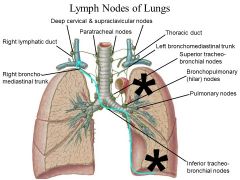![]()
![]()
![]()
Use LEFT and RIGHT arrow keys to navigate between flashcards;
Use UP and DOWN arrow keys to flip the card;
H to show hint;
A reads text to speech;
17 Cards in this Set
- Front
- Back
|
1. List the processes that maintain a supply of oxygen and remove CO2 from the body. |
1. Blood-gas interface
2. Blood-cell interface 3. Ventilation - bulk flow 4. Perfusion – bulk flow |
|
|
1. Explain what is meant by the term ‘partial pressure’ as it relates to a gas mixture or a gas in solution.
|
1. The partial pressure of a gas X in a gas mixture is the pressure that this gas would exert if it occupied the total volume of the mixture in the absence of other components
|
|
|
Explain why deep sea divers are at risk from the bends. |
1. Forces more nitrogen gas into the body at a higher barometric pressure (depth) and then when a diver ascends the backflow causes nitrogen gas to exit the body
|
|
|
Explain the difference between gas partial pressure and gas content or concentration in solution. |
1. Partial pressure is the back flow and the gas content is the amount in solution
|
|
|
1. Describe the primary factor that determines the rate of O2 and CO2 diffusion across the blood-gas and blood-cell barriers.
|
1. Gas diffusion at blood-gas and blood-cell interfaces occurs down partial pressure gradients
|
|
|
List the typical partial pressures of oxygen in the atmosphere, inspired air, alveoli, systemic arteries, cells, systemic veins, and pulmonary artery. |
1. Atmosphere – 159
2. Inspired air – 149 3. Alveoli – 100 4. Systemic arteries – 96 5. Cells – 4 6. Systemic veins – 40 7. Pulmonary artery - 40 |
|
|
Be able to calculate the PO2 of moist inspired air at different barometric pressures. |
1. Barometric pressure – 47 X 0.21
|
|
|
1. List the typical partial pressures of carbon dioxide in the atmosphere, inspired air, alveoli, systemic arteries, systemic veins and pulmonary artery.
|
1. Atmosphere – 0
2. Inspired air – 0 3. Alveoli – 40 4. Systemic arteries – 40 5. Systemic veins – 46 6. Pulmonary artery - 46 |
|
|
Explain why ventilation and perfusion maintain a high rate of gas diffusion in the lung and tissues. |
1. Ventilation and perfusion maintain large gradients for gas transfer
2. Slow rate of Gas transfer is diffusion only 3. Fast rate of Gas transfer is a constant movement of blood via bulkflow helps maintain PP gradient |
|
|
1. Explain the benefit provided by hemoglobin for gas transport around the body.
|
1. Increases the O2 content by binding 4 total O2 and aid with the gradient |
|
|
1. Describe the factors that affect the rate of diffusion of gases across a barrier, and be able to predict the effect of alterations in these factors on diffusion across the blood-gas barrier. |
1. Efficient gas transfer requires a thin barrier of large surface area (Fick’s Law) |
|
|
1. Describe the pathway for diffusion of oxygen across the blood-gas barrier. |
Surfactant to alveolar epithelium to interstitium to capillary endothelium |
|
|
Describe the course of blood flow through the pulmonary circulations |
1. Deliver 5L of blood per minute |
|
|
Describe the course of blood flow through the bronchial circulations |
1. Branch from thoracic aorta |
|
|
1. Trace the flow of lymph through the above nodes and channels to the left or right subclavian veins. |
1. Lymph vessels form many larger vessels |
|
|
1. Describe how the structure of the lung is suited for efficient gas transfer. |
Large surface area with the aveloi and one cell thick to optimize gas exchange |
|
|
Identify and locate the lymph nodes and large lymphatic channels associated with the lungs |

|

